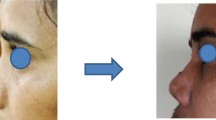Abstract
Rhinoplasty is one of the oldest known surgeries to the human kind. However, being a cosmetic of surgery of utmost importance, it has been an attractive and fascinating surgery for the otolaryngologists and plastic surgeons. Along with the evolution of improved techniques and better surgical modalities, this surgery has been growing in panorama including its indications, needs and techniques. We present our experience with rhinoplasty in a tertiary care center of north India. We have included all cases operated with septorhinoplasty from 2001 to 2014 by the senior author in the manuscript. We reviewed their presentations, investigations, preoperative counselling records, operative details and post-operative clinical records to audit our results and hence to document our experiences in septorhinoplasties. A total of 53 cases including 37 males and 16 females had undergone rhinoplasty surgeries. The most common reason of disfigurement was road traffic accident (58.5%). All these patients included different deformities and required varied corrections. There were no major post-operative complications except persistent edema with longest lasting for 23 weeks. Thermal splints gave a better patient satisfaction in post-op compared to POP splints. Results were completely and partially satisfying for 50 patients and not satisfying for three. Unrealistic expectations from the procedure might be the reason for non-satisfactory results in rhinoplasty. Rhinoplasty is a delicate procedure and has greater aesthetic implications in planning surgical techniques and approaches. For better satisfaction of patients, adequate preoperative counseling and realistic expectations are warranted. Skillful surgical techniques null chances of complications.





Similar content being viewed by others
References
Sorta-Bilajac I, Muzur A (2007) The nose between ethics and aesthetics: sushruta’s legacy. Otolaryngology–head and neck surgery : official journal of American Academy of Otolaryngology-Head and Neck. Surgery 137(5):707–710
Whitaker IS, Karoo RO, Spyrou G, Fenton OM (2007) The birth of plastic surgery: the story of nasal reconstruction from the Edwin Smith Papyrus to the twenty-first century. Plast Reconstr Surg 120(1):327–336
Whitaker EG, Johnson CM Jr (2003) The evolution of open structure rhinoplasty. Arch Fac Plast Surg 5(4):291–300
Byrd HS, Hobar PC (1993) Rhinoplasty: a practical guide for surgical planning. Plast Reconstr Surg 91(4):642–654 (discussion 655-6)
Oneal RM, Beil RJ Jr, Schlesinger J (1996) Surgical anatomy of the nose. Clin Plast Surg 23(2):195–222
Daniel RK (1992) The nasal tip: anatomy and aesthetics. Plast Reconstr Surg 89(2):216–224
Guyuron B (1988) Precision rhinoplasty. Part I: the role of life-size photographs and soft-tissue cephalometric analysis. Plast Reconstr Surg 81(4):489–499
Zijlker TD, Vuyk H, Adamson PA (1992) Rhinoplasty: preoperative photographic analysis. Clin Otolaryngol Allied Sci 17(4):361–369
Sajjadian A, Guyuron B (2010) Primary rhinoplasty. Aesthetic Surg J Am Soc Aesthetic Plast Surg 30(4):527–539 (quiz 540)
Ghanaatpisheh M, Sajjadian A, Daniel RK (2015) Superior rhinoplasty outcomes with precise nasal osteotomy: an individualized approach for maintaining function and achieving aesthetic goals. Aesthetic Surg J Am Soc Aesthetic Plast Surg 35(1):28–39
Guyuron B (1996) Dynamic interplays during rhinoplasty. Clin Plast Surg 23(2):223–231
Guyuron B (2000) Dynamics in rhinoplasty. Plast Reconstr Surg 105(6):2257–2259
Sporri S, Simmen D, Briner HR, Jones N (2004) Objective assessment of tip projection and the nasolabial angle in rhinoplasty. Arch Fac Plast Surg 6(5):295–298 (discussion 299-300)
Petropoulos I, Karagiannidis K, Kontzoglou G (2007) Our experience in open rhinoplasty. Hippokratia 11(1):35–38
Constantian MB (2002) Differing characteristics in 100 consecutive secondary rhinoplasty patients following closed versus open surgical approaches. Plast Reconstr Surg 109(6):2097–2111
Sheen JH (1993) Tip graft: a 20-year retrospective. Plast Reconstr Surg 91(1):48–63
Sajjadian A, Rubinstein R, Naghshineh N (2010) Current status of grafts and implants in rhinoplasty: part I Autologous grafts. Plast Reconstr Surg 125(2):40e–49e
Lee MR, Unger JG, Rohrich RJ (2011) Management of the nasal dorsum in rhinoplasty: a systematic review of the literature regarding technique, outcomes, and complications. Plast Reconstr Surg 128(5):538e–550e
Mahajan AY, Shafiei M, Marcus BC (2009) Analysis of patient-determined preoperative computer imaging. Arch Fac Plast Surg 11(5):290–295
Mehta U, Mazhar K, Frankel AS (2010) Accuracy of preoperative computer imaging in rhinoplasty. Arch Fac Plast Surg 12(6):394–398
Larrabee WF Jr (2010) In praise of rhinoplasty. Arch Fac Plast Surg 12(6):371–372
Funding
This study is a retrospective chart review and was not funded by any funding agency. There are no financial disclosures to be made by the authors.
Author information
Authors and Affiliations
Corresponding author
Ethics declarations
Conflict of interests
We the authors namely, Prof Jaimanti Bakshi and Dr. Sourabha K. Patro declare that we have no conflicts of interests among ourselves.
Ethical Approval
This study being a retrospective chart review of our experience this work is exempted from the ethical committee approval required for any trial on humans. For this type of retrospective study formal consent of institute ethical committee is not required.
Informed Consent
Written informed consent for treatment purposes were obtained from all individual participants who presented to our OPD for rhinoplasty during treatment and surgeries. Additional informed consents were obtained from all individual participants whose identifying information such as photographs have been included in this article.
Rights and permissions
About this article
Cite this article
Bakshi, J., Patro, S.K. Septorhinoplasty: Our Experience. Indian J Otolaryngol Head Neck Surg 69, 385–391 (2017). https://doi.org/10.1007/s12070-017-1127-0
Received:
Accepted:
Published:
Issue Date:
DOI: https://doi.org/10.1007/s12070-017-1127-0




